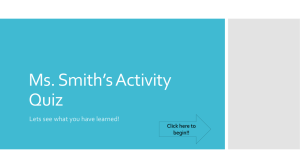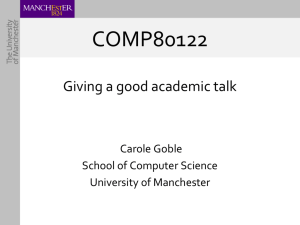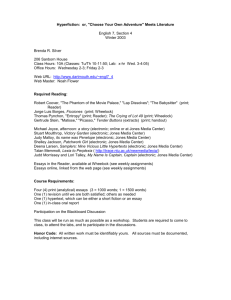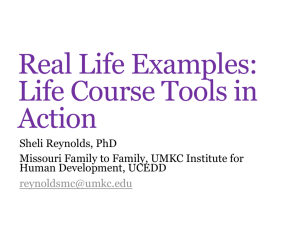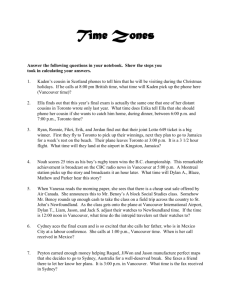Project-report
advertisement
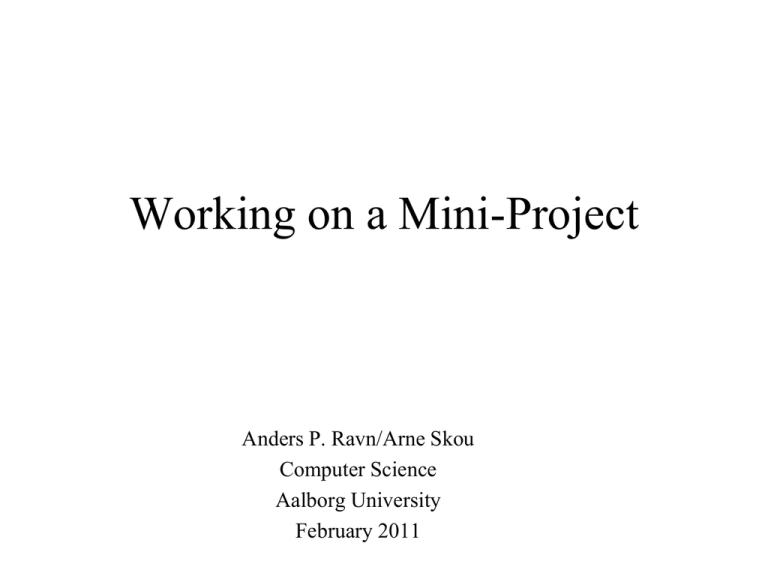
Working on a Mini-Project Anders P. Ravn/Arne Skou Computer Science Aalborg University February 2011 Schedule wrt. Analyis sand Design course • • • • • February 28 – Preliminary version to ASk March 4 – Preliminary presentations March 18 – Status presentations. April 3 – Papers to ASk April 8 – Presentation at Oral Exam The Paper Try writing it as a research paper! • Title A Paper: The title defines the context and the essence of the contribution. A trick I learned from Peter Naur is to write a long complete sentence about it and then remove less essential words until you have something that will fit on a line. Abstract The abstract is a few sentences that gives: The context - what is the problem area? The contribution - what problem is solved? What does the solution achieve? What is the perspective of the solution. I usually rewrite the abstract at least three times: Once in the beginning to get my ideas on paper, once when the body of the paper has been written, and a last time when I have concluded. BODY Body 1. Introduction 2. Technical Parts … N. Conclusion Back Matter: References and Appendices Introduction a) Motivation: Why is this problem area and the specific problem that we attack interesting for the assumed reader? An example is very good, and I try very hard to find a figure that can illustrate it. Note the example should be short and illustrate the idea - it should not be a full case study with lots of details that is for the technical parts. b) The Idea - the contribution. What is the original idea that we present to solve the problem? I try to explain the idea briefly using a minimum of formalism. It may be a good idea to summarize the contributions in a list. c) Related work: Short pointers to related work and a brief sentence about how they are related. I find Simon Peyton Jones' slides [1] on "How to write a great research paper" delightful and very helpful; but I disagree about postponing related work to the conclusion. I agree that a detailed discussion must be postponed. However, a reader that knows the field may find it helpful to see that the author knows central works from the area. d) Overview: Short sentences giving the structure of the remaining sections. I like Peyton Jones' idea: to distribute it in a final write-up over the previous parts; but try writing it in a first version, because then you motivate a structure. Technical Sections The body explains the idea and the solution in detail. It may have several sections:. It must start with a precise description of the problem, including any assumptions that are made. If precision requires formalism, present the relevant special theories. That is, theories which the reader cannot be assumed to know. Exemplify the theory if it is less known with simple examples, and don't forget to use it on the problem! Explain carefully how you use the theory to solve the problem. Explain and discuss experiments, if any. Summarize quantitative data in a way so it easy to compare different experiments, e.g. scale execution times to a 'yardstick' program, give a meaningful number of significant digits, use graphs to display trends. Conclusion It is a summary and assessment of the contribution. It typically contains: a) Summary Recapitulate the result. Remember to discuss related work details. How does this work improve on them? c) Perspective Limitations of the idea, recall the assumptions that were made in the body. How can they be lifted in further work? Back Matter Give Complete References, please. Check for instance a textbook for the form. [1] Simon Peyton Jones: How to write a good research paper , Powerpoint slides, October 2004. Found (Feb. 2006) at: http://research.microsoft.com/~simonpj/papers/giving-a-talk/giving-a-talk.htm A Paper - summary • Introduction – motivation, example, overview • Analysis – problem domain, application domain, related work • • • • Design – theory, data structures and algorithms Implementation Test and Experimentation Conclusion – summary, assessment, further work About writer’s block `Do not worry. You have always written before and you will write now. All you have to do is write one true sentence. Write the truest sentence you know.´ E. Hemingway: A Moveable Feast, Arrow Books, 1996, In the short story Miss Stein Instructs, p. 12.
